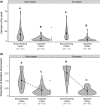Brood-tending males in a biparental fish suffer high paternity losses but rarely cuckold
- PMID: 30182504
- PMCID: PMC6221093
- DOI: 10.1111/mec.14857
Brood-tending males in a biparental fish suffer high paternity losses but rarely cuckold
Abstract
Extra-pair paternity within socially monogamous mating systems is well studied in birds and mammals but rather neglected in other animal taxa. In fishes, social monogamy has evolved several times but few studies have investigated the extent to which pair-bonded male fish lose fertilizations to cuckolders and gain extra-pair fertilizations themselves. We address this gap and present genetic paternity data collected from a wild population of Variabilichromis moorii, a socially monogamous African cichlid with biparental care of offspring. We show that brood-tending, pair-bonded males suffer exceptionally high paternity losses, siring only 63% of the offspring produced by their female partners on average. The number of cuckolders per brood ranged up to nine and yet, surprisingly, brood-tending males in the population were rarely the culprits. Brood-tending males sired very few extra-pair offspring, despite breeding in close proximity to one another. While unpaired males were largely responsible for the cuckoldry, pair-bonded males still enjoyed higher fertilization success than individual unpaired males. We discuss these results in the context of ecological and phenotypic constraints on cuckoldry and the fitness payoffs of alternative male tactics. Our study provides new insights into how pair-bonded males handle the trade-off between securing within-pair and extra-pair reproduction.
Keywords: Variabilichromis moorii; Lake Tanganyika; alternative reproductive tactics; cichlid; microsatellite genotyping; social monogamy.
© 2018 The Authors. Molecular Ecology Published by John Wiley & Sons Ltd.
Figures


Similar articles
-
High frequency of multiple paternity in broods of a socially monogamous cichlid fish with biparental nest defence.Mol Ecol. 2008 May;17(10):2531-43. doi: 10.1111/j.1365-294X.2008.03763.x. Epub 2008 Apr 21. Mol Ecol. 2008. PMID: 18430146
-
Inclusive fitness benefits mitigate costs of cuckoldry to socially paired males.BMC Biol. 2019 Jan 31;17(1):2. doi: 10.1186/s12915-018-0620-6. BMC Biol. 2019. PMID: 30700283 Free PMC article.
-
Nest defense in the face of cuckoldry: evolutionary rather than facultative adaptation to chronic paternity loss.BMC Evol Biol. 2019 Nov 4;19(1):200. doi: 10.1186/s12862-019-1528-7. BMC Evol Biol. 2019. PMID: 31684856 Free PMC article.
-
Monogamy in marine fishes.Biol Rev Camb Philos Soc. 2004 May;79(2):351-75. doi: 10.1017/s1464793103006304. Biol Rev Camb Philos Soc. 2004. PMID: 15191228 Review.
-
Age trajectories in extra-pair siring success suggest an effect of maturation or early-life experience.J Evol Biol. 2023 Sep;36(9):1213-1225. doi: 10.1111/jeb.14201. Epub 2023 Jul 12. J Evol Biol. 2023. PMID: 37438929 Review.
Cited by
-
Freshwater hydrozoan blooms alter activity and behaviour of territorial cichlids in Lake Tanganyika.R Soc Open Sci. 2019 Nov 6;6(11):191053. doi: 10.1098/rsos.191053. eCollection 2019 Nov. R Soc Open Sci. 2019. PMID: 31827845 Free PMC article.
-
Coevolution of female fidelity and male help in populations with alternative reproductive tactics.Proc Biol Sci. 2021 Jan 27;288(1943):20202371. doi: 10.1098/rspb.2020.2371. Epub 2021 Jan 27. Proc Biol Sci. 2021. PMID: 33499789 Free PMC article.
-
Seasonal variation in cuckoldry rates in the socially monogamous cichlid fish Variabilichromis moorii.Hydrobiologia. 2023;850(10-11):2371-2383. doi: 10.1007/s10750-022-05042-0. Epub 2022 Oct 18. Hydrobiologia. 2023. PMID: 37325485 Free PMC article.
-
Single fathers sacrifice their broods and re-mate quickly in a socially monogamous cichlid.Behav Ecol. 2023 Jun 20;34(5):881-890. doi: 10.1093/beheco/arad045. eCollection 2023 Sep-Oct. Behav Ecol. 2023. PMID: 37744163 Free PMC article.
-
Congruent geographic variation in saccular otolith shape across multiple species of African cichlids.Sci Rep. 2020 Jul 30;10(1):12820. doi: 10.1038/s41598-020-69701-9. Sci Rep. 2020. PMID: 32733082 Free PMC article.
References
-
- Alonzo, S. H. , Taborsky, M. , & Wirtz, P. (2000). Male alternative reproductive behaviours in a Mediterranean wrasse, Symphodus ocellatus: Evidence from otoliths for multiple life‐history pathways. Evolutionary Ecology Research, 2(8), 997–1007.
-
- Barlow, G. W. (1991). Mating systems among cichlid fishes In Keenleyside M. H. A. (Ed.) Cichlid fishes. Behaviour, ecology and evolution (pp. 173–190). London, UK: Chapman & Hall.
Publication types
MeSH terms
Substances
Associated data
Grants and funding
LinkOut - more resources
Full Text Sources
Other Literature Sources
Miscellaneous

